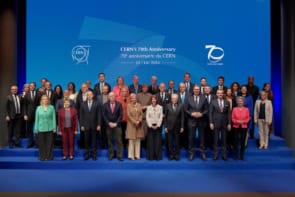
New observations of the flavour composition of atmospheric neutrinos have revealed no conclusive evidence for the minuscule, short-lived black holes that have been predicted by some theories of quantum gravity. The study was done by researchers using the IceCube Neutrino Observatory at the South Pole and the result places some of the tightest constraints ever on the nature of quantum gravity.
Developing a viable theory of quantum gravity is one of the greatest challenges in physics. Today, gravity is described very well by Albert Einstein’s general theory of relativity, which is incompatible with quantum theory. One important difference is that general relativity invokes space–time curvature to explain gravitational attraction while quantum theory is based on flat space–time.
Finding a way forward is challenging because the two theories work at very different energy scales, which makes doing experiments that test theories of quantum gravity very difficult.
“Creative measurements”
“In recent years, creative measurements have been devised to search for the tiny influence of quantum gravity: either via the use of extreme precision in laboratory experiments, or by exploiting the highly energetic particles produced in the distant universe,” explains Thomas Stuttard at the University of Copenhagen, who is a member of the IceCube collaboration.
Among these new theories is the idea that the quantum effects of uncertainty, combined with energy fluctuations in the vacuum of space, could have a tangible effect on the curvature of space–time, as described by general relativity. This could result in the creation of “virtual black holes”. If they exist, these microscopic objects would decay on the order of Planck time. This is about 10−44 s and is the smallest interval of time that can be described by current physical theories.
As a result, virtual black holes would be impossible to detect in the lab. But, if they really exist, researchers predict that they should interact with neutrinos, altering how the particles change flavour states via the phenomenon of neutrino oscillation.
Cubic kilometre of ice
The team searched for evidence of these interactions in data collected by the IceCube Neutrino Observatory, located at the South Pole. As the world’s largest neutrino observatory, IceCube consists of thousands of sensors positioned throughout a cubic kilometre of Antarctic ice.
These sensors detect distinctive flashes of light created by charged leptons that are produced why neutrinos interact with the ice. In this latest study, the team focussed on IceCube detections of high-energy neutrinos produced when cosmic rays interact with Earth’s atmosphere.
Stuttard explains that their search is not the first of its type. “This time, however, we were able to exploit the naturally high energy and large propagation distance of these ‘atmospheric’ neutrinos (rather than earthbound neutrino sources such as particle accelerators or nuclear reactors), as well as the high statistics afforded by the vast detector size. This enabled us to search for effects far weaker than can be probed by any previous study.”
Flavour composition
In their study, the team examined the flavour composition of over 300,000 neutrinos, observed by IceCube over an 8-year period. They then compared this result with the composition they expected to find if the neutrinos had indeed interacted with virtual black holes on their journey through the atmosphere.
Even with the extreme sensitivity offered by IceCube, the results were not any different from the flavour compositions predicted by the current model of neutrino oscillation. For now, this means that the theory of virtual black holes remains without any conclusive evidence.

Getting closer to measuring quantum gravity
However, this null result did allow the team to place new limits on the maximum possible strength of black hole–neutrino interactions, which are orders of magnitude more stringent than the limits set in previous studies.
“Aside from quantum gravity, the result also serves to demonstrate that the neutrino does appear to remain truly unperturbed by its environment even after travelling thousands of kilometres, even for neutrino energies exceeding any man-made collider,” says Stuttard. “This was a remarkable demonstration of quantum mechanics over truly macroscopic distances.”
More broadly, the team’s findings place new constraints on the theory of quantum gravity as a whole, constraints that are currently few and far between. “Whilst this work rejects certain scenarios, quantum gravity as a concept is certainly not excluded,” Stuttard adds. “The true nature of quantum gravity may differ from the assumptions made in this study, or the effects may be weaker or more strongly suppressed with energy than previous thought.”
The research is described in Nature Physics.



